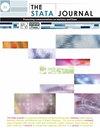在连续处理中使用熵平衡来估计剂量-反应函数及其衍生物
IF 3.2
2区 数学
Q1 SOCIAL SCIENCES, MATHEMATICAL METHODS
引用次数: 0
摘要
最近,人们对评价连续治疗的剂量-反应函数越来越感兴趣。为了方便在这种情况下估计因果效应,我介绍了ebct命令,用于使用熵平衡对连续处理估计剂量-反应函数及其衍生物。首先,通过数值求解全局凸优化问题来估计平衡权值。这些权重消除了协变量和治疗变量之间的Pearson相关性。因为简单的不相关可能不足以在下一步中产生一致的估计,所以处理变量的较高矩可以表示为与协变量不相关。其次,在局部线性核回归中使用权值来估计剂量响应函数或其导数。为了执行统计推断,我使用了一个引导过程。该命令还提供了为估计的关系生成发布质量图的选项。本文章由计算机程序翻译,如有差异,请以英文原文为准。
ebct: Using entropy balancing for continuous treatments to estimate dose–response functions and their derivatives
Interest in evaluating dose–response functions of continuous treatments has been increasing recently. To facilitate the estimation of causal effects in this setting, I introduce the ebct command for the estimation of dose–response functions and their derivatives using entropy balancing for continuous treatments. First, balancing weights are estimated by numerically solving a globally convex optimization problem. These weights eradicate Pearson correlations between covariates and the treatment variable. Because simple uncorrelatedness may be insufficient to yield consistent estimates in the next step, higher moments of the treatment variable can be rendered uncorrelated with covariates. Second, the weights are used in local linear kernel regressions to estimate the dose–response function or its derivative. To perform statistical inference, I use a bootstrap procedure. The command also provides the option of producing publication-quality graphs for the estimated relationships.
求助全文
通过发布文献求助,成功后即可免费获取论文全文。
去求助
来源期刊

Stata Journal
数学-统计学与概率论
CiteScore
7.80
自引率
4.20%
发文量
44
审稿时长
>12 weeks
期刊介绍:
The Stata Journal is a quarterly publication containing articles about statistics, data analysis, teaching methods, and effective use of Stata''s language. The Stata Journal publishes reviewed papers together with shorter notes and comments, regular columns, book reviews, and other material of interest to researchers applying statistics in a variety of disciplines.
 求助内容:
求助内容: 应助结果提醒方式:
应助结果提醒方式:


